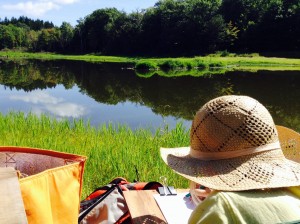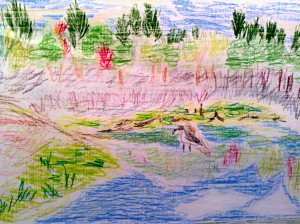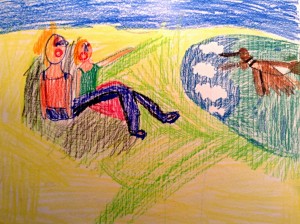“Anything but science.” I’m not sure when that became my mantra. Maybe it was in ninth grade, in Earth Science, when the belligerent varsity soccer coach/teacher loomed over me as I stared through the stereoscopic lenses at the aerial topographic photograph. Lacking depth perception, I couldn’t see a single three dimensional image. He breathed heavily through his nose in disgust. Maybe it was in tenth grade, dissecting the grasshopper, when the messy anatomy of the formaldehyde-drenched creature looked nothing like the drawings I was supposed to label. If I couldn’t see and identify the parts in the workbook, I would fail the lab portion of that class. I had to go home and look it up, filling the blanks in from more flat drawings. Maybe it was in eleventh grade, when I couldn’t understand the path of electricity in physics outlined on the written sheet, failed to follow the instructions properly, and burned up the fuse on the ammeter. I had to copy the answers to that worksheet from my lab partner. If there is a subject that makes my body tense with anxiety before my eyes glass over in self-defensive dismissal, it is science.
When Bob and I decided to homeschool, we made a deal. He was teaching science. Or, in his absence, my dad, the animal scientist, would handle it. I would handle everything else.
But that’s not how things have been going these past few weeks. Our intern went back to school, and Bob cannot predictably get a day off to handle science instruction. Last week he quickly covered the textbook content of Saoirse’s lesson, then pushed the rest aside. “She needs to go to a pond and study water samples and aquatic life,” he mentioned in passing. “I need to move fence. It’s just not happening.” He took Ula birding quickly in the early morning, then headed down to the farm. Saoirse was left with her textbook to finish out her lesson.
Saoirse is a sponge about everything she reads. I knew that Bob’s need to rely on the text for a week wouldn’t result in any educational loss. Thus, I left her to her work, and turned to Ula. In order to complete her lesson, we were supposed to write briefly about her experience, and she was to draw a picture of what she had seen.
She and her dad had been watching nuthatches. Thus, to help us out, Bob left behind a field guide open to a picture for us to refer to.
Ula is not able to write up her observations on her own. According to the doctors, her visual impairment limits her ability to read. She cannot form letters correctly unless I give her lines to trace. She is unable to change focus from one distance to another, and she has poor visual memory. Staring at a drawing of a nuthatch and then attempting to create her own was a recipe for disaster. Within seven minutes, she was in tears.
Here we are, at the start of the new school season, the science expert is down on the farm, and this kid is staring at me through her thick lenses, wondering when I’m going to teach her something worth knowing besides eye charts and the proper direction of a lowercase b.
The simple truth about me is that, if it can’t be read out of a textbook, I don’t know to teach it. That works fine for Saoirse. But it is becoming clear to me that Ula’s education will not come from a textbook. Seeing her tears over her failed drawing, I take her science notebook and put it in the cupboard. I don’t know how to help her, and we’ve both had enough frustration for one day.
The next day, while out on my morning hike before starting lessons, I observe that the sky is a glorious late-summer blue, the goldenrods are resplendent, and the earth is vibrating with the hum of crickets. A pang of guilt shoots through me as I review my morning lesson plans, where Saoirse and Ula will be hostage to homeschool at the kitchen table. And suddenly, the math, the reading lessons, and the spelling all seem trivial next to this day. I think about Bob’s unfinished science lessons, and decide to muster my courage.
I return to the house and enlist the girls’ help. We gather drawing boards, tupperware containers, colored pencils, binoculars, bottles of water, and a few snacks. We head up into the state land, to a pond that rarely sees foot traffic. We settle ourselves down by the water. Saoirse begins scooping up pond weeds and catching frogs. Ula looks to me for instruction.
“What do we do now?” She asks.
I hand her a drawing board and the colored pencils. “We wait,” I tell her, “and see if something comes along. In the meantime, just draw what’s around you.”
She begins sketching a castle. I forget that it is easier for her to work from her imagination than it is for her to translate what she sees in front of her. “No castles today,” I take away her paper and hand her a fresh sheet. “You need to draw from what’s here. You don’t have to draw all of it,” I tell her, “just choose something that it is here, a small bit of it, and do your best.”
We work for over an hour, barely speaking. I lose myself in the landscape, in trying to capture the reflection of the forest and clouds on the water, the first red leaves on a few of the maples, the shape of the conifers as they reach for the cerulean sky. Ula is so quiet, I forget about her sitting beside me. I lose my awareness of Saoirse’s fieldwork.
A snipe flies across the water, then settles in front of a fallen log in a shallow section. It seems to have disappeared. Ula hands me the binoculars so that I can find it for her, and I marvel how, the bird is so well camouflaged against the fallen log, I must stare at the reflections in the water to pick it out. Thus located, I hand the binoculars to back to her, worried that she will be unable to find the creature. But she does. And there she sits, watching it, completely still, until it takes off and flies from view. Ula goes back to her drawing.
An hour later, the chiming of my alarm alerts me that it is time to go. But first, Ula wants me to help her write up her notes. This is what she dictates:
I saw a bird and drew a perfect picture of it. He flew away, but then he flew back again.
I hand her the lined paper so that she can trace her letters, and she hands off her drawing as she sets to work. I stare down at the picture. She has captured the snipe on her paper with startling accuracy. And not only that, she has managed to observe and re-recreate the stunning reflections of the surrounding mountains and sky in the water. But there is one other interesting facet to this drawing.
She has sketched me, sitting beside her, watching the bird.
Sometimes it frightens me to consider how much my children learn by my example. But on this day, I feel so grateful that she has captured me doing something right. And I realize, as I gaze at this child’s drawing of us watching a bird, how I have lived for forty years, gathered 10 years of higher education under my belt, and never, before this moment, understood the foundation of science.
The foundation of science is a sense of wonder. It isn’t about pulling apart dead grasshoppers and filling in worksheets. It isn’t about accurately reciting the path of electrical currents, or standing over a lab desk scrutinizing flat photographs. It is first and foremost about stepping outside the busy clutter of our minds, and marveling at the world around us: the way that light hits water and causes reflection, the behavior of a shy bird, the way the same trees each year are the first to surrender their chlorophyl and allow their autumn beauty to emerge.
The girls and I gather our things together. Saoirse is proudly showing me her collection of photographs and notes. Ula watches over me to be certain I don’t wrinkle her drawing as I stow it away. We pick our way through the brush, back up to the trail, then turn to face the pond one last time before leaving. “Thank you!” The girls call out to the scene behind them as we make our trek back.
This is the first day I think I may have managed to successfully satisfy Ula’s pursuit for scientific discovery. As we leave, she turns to face me. “Can we do this again?” she asks.
Finally. One experiment that I didn’t fail.




Beautiful post, Shannon. I’m a wildlife biologist and I also volunteer as the science teacher for my kids’ Montessori school (ages 3-11). I like to say I don’t really teach science; I teach wonder, delight and awe. I call my methods “‘qualitative, not quantitative”. I’ve found that science is best appreciated experientially and nature often provides the best classroom.
I figure those students that are cut-out for quantitative and experimental science will follow their curiosity and get there naturally, joyfully. I learned this both from the pain of my own utterly stultifying science education and from the subsequent saving grace of Rachel Carson’s wise essay, “The Sense of Wonder”. Highly recommend it.
Hey Shannon- just a thought, perhaps one that you have already entertained; would you consider making your next “production” a compilations of your Tuesday Blogs? Jeanne, Shei and I really enjoy your “ramblings”!!! Think it would be good read. Sure gives my family hope for the “green future” of our mother earth.
Thanks kiddo!
Ron
Funny you should bring that up! We’re working on it!
I love, love reading your blog Shannon! I always read it but don’t reply because your thoughtful writing is a hard act to follow, and because of time constraints. So if you don’t mind, I’ll just throw out a couple of quick thoughts and be on my way.
By way of affirming your experience. I am a ‘retired’ homeschool mom. I was totally intimidated at the thought of teaching science. I also remember the freeing revelation that the study of science being nothing more than training in objective observation. Nothing more? It’s everything! As so, it’s not possible for an experiment to “fail”. A failed experiment is a learning experiment.
Regarding your daughter’s vision status. Have you consulted a developmental ophthalmologist? Vision therapy worked wonders for my son. I had no idea there was such a thing and I most certainly no idea he had trouble tracking- he was very bright, read voraciously since young. He’d had learned to compensate but hit a wall when he met higher maths.
There is a helpful book written by a person who didn’t even know she saw things differently than most, and upon discovering that she had 2D vision, and through vision therapy, acquired 3D vision, and how it changed her world. I don’t recall the title, and long ago passed it along. Perhaps someone else will know.
Thank you for sharing these thoughts, Cynthia. Yes, we eat, sleep and breathe vision therapy these days! I would love to know the title of that book, if ever you should remember it. Shannon
Vision therapy is intense and time consuming and seems like it will never end.. Funnily and thankfully my guy loved it. The name of the book will pop into my head- just no predicting when. But I’ll get it to you when it does.
Shannon I really love your blog and reading about your life. I have only recently begun the journey of learning how I can live more sustainably in my urban life as a single mother in Louisville, KY. I have dreams of learning more and more about growing my own food and maybe one day owning land and running a small farm. I value a lot of the same things I assume from the way you live your life that you value as well. Im curious to know how you took that plunge and what resources are available for someone who wants to explore this way of life? Thank you for your heartfelt sharing- it is truly an inspiration!
Shannon: What a beautiful post. It took me back to my youthful days of science – catching frogs and salamanders, looking for monarch butterfly caterpillars on milkweed (and catching them and feeding them until they turned into butterflies!), looking at bugs under rocks, collecting rock fossils…Or the one time I left a chicken bone in vinegar to discover it completely dissolved.
Curiousity is truly what’s most important for a scientific mind, or truly, any mind worth having.